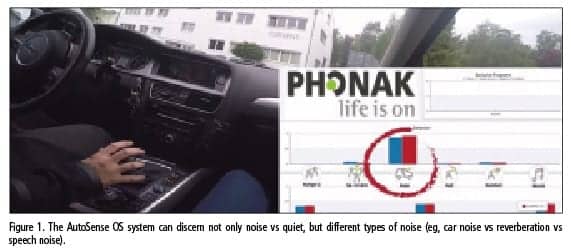Tech Topic | September 2016 Hearing Review
In addition to faster processing than previous Phonak automatic steering systems, AutoSense OS is increasingly advanced in its ability to quickly detect the acoustic environment in real-time, and seamlessly adjust nuanced algorithms in the hearing aid accordingly. Additionally, this powerful technology has been implemented into the Phonak Sky V product line and has been further customized to recognize environments specifically encountered by pediatric users.
People encounter a wide variety of listening environments in everyday life. They may start their day alone in a quiet apartment, then drive to meet a friend for coffee in a busy café, and later spend a couple of hours in a noisy shopping mall. For those with hearing loss, hearing aids need to accommodate a wide variety of acoustic environments so that different listening scenarios are not hurdles to enjoying a full and satisfying social life.
There is no doubt that the scope of hearing aid sophistication has increased dramatically over time. Gone are the days of single-channel analog devices tuned with a screwdriver. Hearing aid programs have become more sophisticated and specific to accommodate many unique listening environments.
However, when manual hearing aid programs are used, hearing aid users must change programs themselves as they move through different environments. We know that manually changing programs throughout the day can be a nuisance, and research shows that compliance and consistency for switching programs manually can be difficult, even for savvy hearing aid users.1 Listening environments are often complex hybrids of acoustic stimuli, and therefore may not fit into the concrete characterizations provided by manual hearing aid programs.
For these reasons, Phonak recognized the necessity to increase sophistication and specificity of hearing aid programs with implemented accessibility that adds no responsibility on the part of the hearing aid user. Automatic programs enable hearing aid users to wear their hearing aids without having to think about switching between hearing aid programs. The hearing aids essentially make their own decisions about the listening environment, just as the brain does.
Evolution of Acoustic Scene Analysis
First used for transcribing dictation, as well as security and military applications, sound classification systems originated well outside the area of hearing aids. Sound classification was first implemented in hearing aids in the 1990s, with the underlying processing modeled after acoustic feature analysis used by the human auditory system. In simple terms, the system worked by pulling acoustic characteristics from the environment, and matching these characteristics to a set of predefined acoustic scenes. Since the introduction of automatic auditory classification, these algorithms for identifying environments have become increasingly advanced.
Today, identification of the acoustic scene is only half of the story, as automatic systems in hearing aids must also adjust and adapt parameters to optimize listening in any and all acoustic situations based on those classifications. The number of parameters adapted per environment has increased dramatically over time. In the case of hearing aid automatic systems, not only is it now a priority to optimize speech intelligibility, but automatic feature steering also needs to take comfort and sound quality into account when determining the best adaptation of parameters for a given environment.
A New Automatic Classification System
AutoSense OS is the latest generation of the Phonak automatic classification system and is substantially more flexible, precise, and accurate than previous automatic systems. The advanced proprietary chip offers faster processing, greater memory capacity, and less power consumption. This technology is designed to ensure that hearing aid users never have to worry about making adjustments, because it is able to quickly analyze the acoustic environment in real-time and adjust the hearing aid parameters accordingly.
There are seven different sound classifications within AutoSense OS: 1) Calm Situation; 2) Speech in Noise; 3) Speech in Loud Noise; 4) Speech in Car; 5) Comfort in Noise; 6) Comfort in Echo, and 7) Music. (Author’s note: Description of programs pertains to the 90-level of Phonak technology.)
In three of the programs, an exclusive program is activated. When one of these three environments is encountered, the hearing aid smoothly transitions into an exclusive program specifically designed for that environment.

Due to the proportion of mixing of programs, AutoSense OS can activate over 200 unique and audibly different hearing aid settings. In this way, the hearing aids can adapt to complex listening scenes that may not fit into the description of one concrete manual program. This leads to a fluid listening experience that directly reflects the complexity of everyday life and cannot be achieved through manual programs.
The ability of AutoSense OS to adapt very specific parameters based on the different sound classifications to optimize hearing performance is unique. The parameters available to AutoSense OS for adaptation are extensive, and include gain model adjustment, directional microphone pattern changes, as well as adjustment of sound cleaning features.
The new system also has an extremely wide array of detectable environmental characteristics to improve listening and comfort in complex and difficult listening environments. These classifications include the ability to detect reverberation, as well as to identify the difference between situations prioritizing comfort versus intelligibility.
AutoSense OS is also designed to minimize misclassification, which ensures comfort for speech understanding is not impacted. For example, the hearing aids must detect a particular type of environment for a certain amount of time, and at a particular level, prior to a complete switch of programs. The transition of switching between programs is done quickly so that conversation is not missed and changes are so seamless that, even between programs of drastically different gain models and parameter settings, there are no abrupt program changes that would be audible to the hearing aid user. This delicate balance between quick switching of parameters to allow audibility of every word in running speech, with seamless and inaudible transitions, is a defining characteristic of the new system.
Application of Advanced Techology in Real-world Listening Environments
Phonak Audiology Research Center (PARC) recently conducted a study assessing the accuracy and resulting speech understanding performance of AutoSense OS, compared to manual hearing aid programs.2 The study was specifically designed to compare the performances of AutoSense OS with manual hearing aid programs in three real-world challenging listening situations (in a car, at a coffee shop, and in a reverberant room at PARC). The outcome of this study showed better speech understanding performance and subjective ratings between classification and adaptation provided by AutoSense OS and a manual program chosen by the participant as his or her “favorite” for each listening environment.
Advanced Technology for Pediatrics
This technology has now been implemented into the Phonak Sky V product line for pediatrics. When manual hearing aid programs are offered to children, the use of additional manual programs is uncommon.3 Hearing aids are often programmed with either a calm situation or FM program at the start. Directional microphones are often avoided due to concerns that children will inadvertently switch into this program and result in a suboptimal listening experience. An automatic program eliminates this potential mishap, because the directional microphone is only enabled when indicated by the environment. Additionally, the Sky V product line has been further customized to recognize situations specifically encountered by children.
Research has shown that the listening environments of children are very different than those encountered by adults (Phonak Market Insight). A study conducted by Phonak found that environments—such as sitting in a classroom, working in small groups, playing in a playground, and listening to music—are common for children. Phonak Sky Venture products are designed to better detect group work situations and peer conversations, as well as improve comfort when children are yelling on the playground.
By providing more than a single manual program, which has typically been the case in pediatrics, children experience greater comfort and speech understanding. This allows children to hear what their teachers are saying and engage with their classmates in and out of the classroom.
Benefit to Hearing Care Professionals
In the past, hearing care professionals may have been hesitant to offer multiple programs in manual program hearing aids, given the risk of their patients encountering difficulties switching programs or forgetting to switch between programs. These professionals can now trust that AutoSense OS not only provides convenience, in that hearing aid users never have to worry about switching programs manually, but is also going to be the best option for providing optimal hearing aid performance in everyday listening situations. Speech intelligibility is optimized, while comfort and sound quality is maintained. In fact, it is designed to provide a better listening experience than even a savvy experienced hearing aid user could receive with a push-button—and without the hassle.
Within the fitting software, AutoSense OS is unparalleled in its flexibility and customizability. Hearing care professionals can manipulate the blending characteristics of AutoSense OS itself, but also have control over several parameters within each individual program to best suit the needs of each hearing aid user.
Summary
Automatic capability in hearing aids helps to simplify and improve the quality of lives with a seamless listening experience. AutoSense OS is designed to offer this hands-free listening experience, while also providing a way for hearing aid users to access a full repertoire of hearing aid program parameters designed for the acoustic complexity of the real world.
References
-
Desjardins JL, Doherty KA. Do experienced hearing aid users know how to use their hearing aids correctly? Am J Audiol. 2009; 18:69-76.
-
Jones C, Feilner, M. Fitting and usage of hearing instruments in pediatrics. Proceedings of a sound foundation through early amplification. 2013; 11. Available at: http://www.phonakpro.com/content/dam/phonak/gc_hq/b2b/en/events/2013/chicago/Fitting_and_usage_of_HIs_in_Peds_SF2013_Jones.pdf
-
Rakita L, Jones C. Performance and Preference of an Automatic Hearing Aid System in Real-World Listening Environments. Hearing Review. 2015;22(12):28. Available at: https://hearingreview.com/2015/11/performance-preference-automatic-hearing-aid-system-real-world-listening-environments
Lori Rakita, AuD, is a research audiologist at the Phonak Audiology Research Center (PARC) in Warrenville, Ill.
Correspondence can be addressed to HR or Dr Rakita at: [email protected]
Original citation for this article: Rakita L. Automatic Feature Steering and Adaptation for Seamless Listening Experiences. Hearing Review. 2016;23(9):26.?





